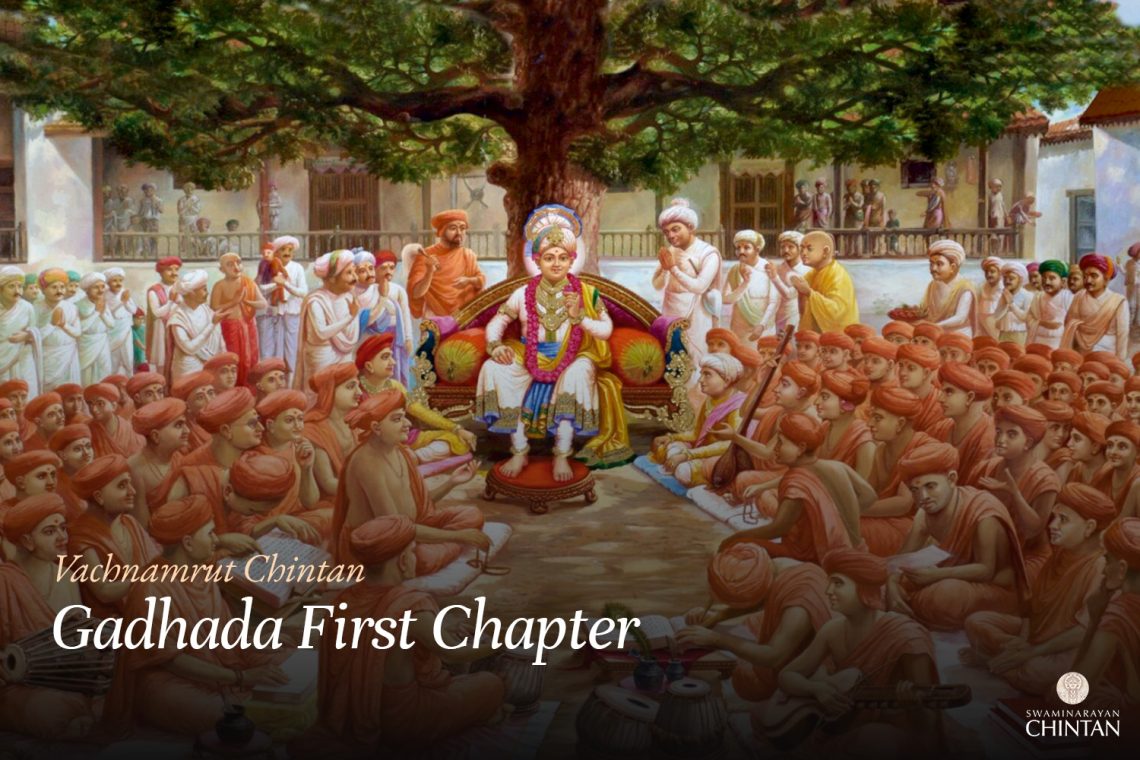Central Insights:
- The form of God is resides with His Akshardham
Key Points:
- One who does not truly perceive God’s form does not possess true longing for the path of liberation.
Explanation
In this Vachanamrut, Maharaj initiates the discourse with a question-and-answer session. Somlakhachar inquires: “God forgives all offenses of His devotees, but which offense does He not forgive?” Maharaj responds, “God forgives all offenses except for the betrayal of His devotees. Betrayal of a devotee is an unforgivable offense.”
In addition, to denounce the form of God is also a big sin. This sin is even greater than the five grave sins. That is why this sin should never happen. God resides forever within Akshardham with a divine form. When He graces the Earth with His presence, any element that comes within His contact becomes Bhramroop (attain a divine form). Inanimate objects become Bhramroop as well. During incarnations like Ram and Krishna, although their three bodies, states, senses, and life forces appear human-like, they remain divine, not material. Thus, denying God’s form should never be done.
Maharaj then questions the sages: “If one has firm conviction in God and follows the principles of satsang (spiritual fellowship), will they attain liberation? This is the path of satsang. But, can one attain liberation by following scriptures without satsang? Adi Shankaracharya considered liberation through formless meditation as per scriptures, while Ramanujacharya considered liberation through devotion to a personal form of God. These acharyas based their paths on scriptures. What have you concluded based on scriptures?”
Here the Saints denounced the scriptures that preached God as formless and supported the scriptures that encouraged salvation through recognition that God has a form. Here Māharāj agrees with them and extends their understanding further by asking: “If God, who is beyond Akshar, arrives on Earth in mortal form, do devotees that have the desire to see His transcendental form in His divine abode versus His mortal form have firm faith or not? Here the Saints respond that it does demonstrate firm faith.
Māharāj casts a doubt. What sin does the person commit by having the desire of seeing the divine form within His abode? The Saints respond that it is not a sin. Bhramamahol (Abode), Gaulok abode etc. are all heavens of God as well. But the divine abode alone should not be pursued without God in it as well.
Maharaj then asked, “If the divine abode and its residents are conscious entities beyond Maya, what is the fault in desiring them? The earthly manifestation of God and His servants may perish, but the divine forms and servants are eternal. What distinguishes the divine form on earth from the divine form in the abode, making the former complete and the latter incomplete?” The sages had no answer, so Nityanand Swami suggested Maharaj should respond.
Maharaj clarified that His questioning did not imply any deficiency in the sages’ answers. His aim was to highlight the truth. Maharaj’s conclusion was that when God manifests on earth, His form and servants are as divine as in the abode. There is no diminution in divinity. On the contrary, the earthly manifestation may hold unique qualities. God’s form, whether in the abode or on earth, is complete with six divine attributes. As stated in the Gita, “Assuming control over My divine nature, I manifest by My own power” (Gita 4.6).
Thus, when necessary, God may reveal His divine form to a devotee even in His human form, covering His divine powers out of compassion. Therefore, His divine attributes remain the same.
The radiant, divine form of God in the abode is not diminished when He manifests on earth. The attributes of compassion, like uplifting the fallen and protecting the surrendered, are prominent in the earthly manifestation. These attributes are also present in the divine form but are not expressed in the abode due to the lack of fallen souls needing redemption. Thus, they manifest fully during God’s earthly incarnations.
Mumukshus (aspirants for liberation) and seekers need God’s compassionate attributes more than His radiance. These attributes act as a life-saving elixir, essential for escaping worldly entanglements. Therefore, the earthly manifestation is uniquely beneficial for Mumukshus. Lack of recognition of these attributes indicates ignorance and lack of true devotion. Those who prefer the divine form over the earthly form are misguided.
Maharaj concludes that the form on earth provides certainty of liberation, while desire for the divine form without engagement in the earthly form brings doubt. Both forms are essentially the same, but distinctions are made for understanding. Ultimately, Maharaj reveals that when God manifests for the benefit of souls, He brings His divine attributes and associates with Him. His grace makes the earthly form appear ordinary, and He accepts service from earthly devotees to elevate them to divinity.
Those unaware of this truth desire the divine form. As Maharaj said in Vach.G.P 7, hearing about God from an ignorant person is harmful. Therefore, Mumukshus should be engrossed in the earthly form to attain the divine form. Desire for the divine form without engagement in the earthly form leads to uncertainty.
Maharaj emphasized that God’s form, whether divine or earthly, is one. Divisions are made for comprehension. He affirmed that when God manifests on earth, He brings His divine abode and associates. Out of compassion, He accepts service from earthly devotees over divine associates to elevate the former. This truth is for those lacking awareness of God’s attributes.
In conclusion, Maharaj highlights the necessity of engaging with the manifested form of God for true liberation. This engagement ensures realization of the divine form and attributes, leading to ultimate liberation.
Glossary
| Akshardham – The eternal supreme abode of Bhagwan Shree Swaminarayan |
| Bhramamahol – Divine abode of God |
| Bhramroop – Attaining a divine form, Free from the three attributes of maya |
| Golok – The divine abode of Bhagwan Shree Krishna |
| Mumukshu – Seeker of liberation (Moksha) |
| Satsang – Holy fellowship or association with saints and devotees. |

